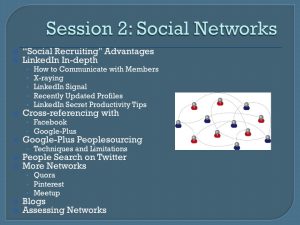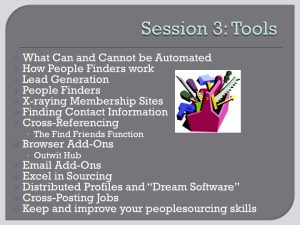“It’s not rocket science,” she says. There’s even a slide to confirm this.
I look around the room and several mouths are left open as the attendees remain fixated on the screen not quite believing what they just saw. I can’t tell you what they saw either; it’s secret and would send shivers up the spines of the owners of certain social media platforms.
“Can you do that again. This time a bit slower,” someone asks.
I’m attending Irina Shamaeva’s two day People Sourcing Certification in San Francisco in The Penthouse Suite of TalentBin’s offices. I’ve had worse views.

The course is at two levels and looks at Search, Social and Tools then there is homework and then an examination.
I know this stuff and I’m wondering what I’m going to learn. I guess the other participants are too and whether they will get sufficient ROI ? Have they picked the right course? Will they make extra placements and what are the lunch options ?
The room is a mixture of contract recruiters, newbies, veterans, agency and corporate recruiters.
Here’s the agenda for all three parts (Day 2, advanced):


 There’s a lot of material here and it’s covered in depth as each session lasts 90 minutes. At the end of each, we have a break and the students eagerly try out their new skills. Sometimes it works but most of the time it doesn’t so we try again and again until it does.
There’s a lot of material here and it’s covered in depth as each session lasts 90 minutes. At the end of each, we have a break and the students eagerly try out their new skills. Sometimes it works but most of the time it doesn’t so we try again and again until it does.
Lesson 1 – Practice
Now it’s not like we haven’t seen this stuff before, we are all sourcers right? We all know about Boolean and search engines, social media have a few tricks of our own, but the difference is the level of understanding. We start digging under the hood of html throw a big lump of data into Excel and out again with the bits we want. We even start looking at url’s and what they mean, what happens when we change them, what do the component parts represent and how by knowing this do we use it to find better candidates?
“Why are we talking about such jibberish?” she asks. “Because we want to learn what can be found and what can be not.”
And that’s it isn’t it? If we really understand this then as sourcers, we know what can be done, but more importantly, we know what can’t.
Lesson 2 – Be inquisitive and then some
Social and tools are both fast paced sessions. LinkedIn is heavily featured and rightly so: it’s the No.1 current platform for finding people. However it’s also the No.1 platform for every recruiter in the world sending countless irrelevant messages to constantly hounded candidates. So we have to be able to think differently, work differently and find those people Joe Soap won’t.
(We also have to present our opportunity to them in the best way, but that’s another subject.)
Lesson 3 – Think different
All the social media platforms are covered and a few others.
All of the above and hundreds (thousands maybe?) more are places where potential hires hang out. And then we have all the tools at our disposal, however many there are with new ones appearing every day. That’s great (and keep them coming) but it’s difficult to keep on top of all them with a day job!
Does it matter if we remember every tool or trick we have been shown? I say no.
What I realise after two days is that the real lesson we are being taught is that as a sourcer you have to have a certain mindset. Everything you look at can be a potential candidate finding, attraction or messaging tool. It’s your job to work it out.
Lesson 4 – Get the mindset
But the fun bit of course is when it works. Or you create your own shortcut, hack or more efficient way of doing things. What does Irina say?
“We can use things in a way they aren’t intended to give us an advantage.”
Lesson 5 – Try and break stuff!
Keeping on top of latest technologies, search engines and the like can be a full time job on its own and the day job doesn’t help. Setting time aside to dedicate purely to training whether it be face-to-face or online is an investment in yourself. Better still, if it costs money, get the boss to invest.